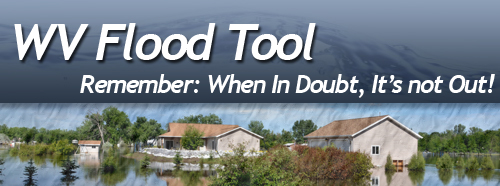Glossary
| Advisory Flood Height | The water surface elevation (WSEL), in feet, of the 1% annual chance (100-year) flood at a given location, as determined using hydrology and hydraulics (H&H) analysis and the best available elevation data. This information is currently available for 34 of the 55 West Virginia counties. |
| Approximate Study | An engineering study that results in the delineation of floodplain boundaries for the 1-percent-annual-chance flood, but does not include the determination of BFEs or base flood depths. (http://www.deltacouncil.ca.gov/glossary/approximate-study) |
| Base flood | "The flood having a one percent chance of being equaled or exceeded in any given year." AKA the 100-year flood. (http://www.fema.gov/plan/prevent/floodplain/nfipkeywords/base_flood.shtm) |
| Base Flood Elevation (BFE) Line | These lines represent the rounded whole-foot water surface elevations (WSEL) of the 1-percent-annual-chance flood. (BASE FLOOD ELEVATION (BFE) LINES OF THE DIGITAL FLOOD INSURANCE RATE MAP (DFIRM) - MARCH 2010) |
| Community Rating System (CRS) | "The National Flood Insurance Program's (NFIP) Community Rating System (CRS) is a voluntary incentive program that recognizes and encourages community floodplain management activities that exceed the minimum NFIP requirements. As a result, flood insurance premium rates are discounted to reflect the reduced flood risk resulting from the community actions meeting the three goals of the CRS: 1. Reduce flood damage to insurable property; 2. Strengthen and support the insurance aspects of the NFIP, 3. Encourage a comprehensive approach to floodplain management. (http://www.fema.gov/national-flood-insurance-program/community-rating-system.shtm) |
| Cross Section (XS) Line | Representation of the location of channel surveys executed in order to provide input to the hydraulic model used to calculate flood elevations. These locations are also shown on the flood profiles found Flood Insurance Study (FIS) reports. (FLOODPLAINS_CROSSSECTION_DFIRM_IDNR_IN: DFIRM Floodplain Cross section Lines for 86 of 92 Counties in Indiana (Indiana Department of Natural Resources, 1:12,000, Line Shapefile)) |
| Detailed Study | An engineering study that results in the delineation of floodplain boundaries for the 1-percent-annual-chance flood, and also includes the determination of BFEs or base flood depths. |
| DFIRM | (D)igital (F)lood (I)nsurance (R)ate (M)ap. The digital implementation of the FIRM. (http://www.fema.gov/plan/prevent/fhm/dfm_dfhm.shtm) |
| FIRM | (F)lood (I)nsurance (R)ate (M)ap. "The official map of a community on which FEMA has delineated both the special hazard areas and the risk premium zones applicable to the community." (http://www.fema.gov/hazard/map/firm.shtm) |
| Flood Hazard | The physical phenomenon of high water associated with, for example, a stream, water body, shoreline or area of ponding, and the likelihood of its occurrence. Hazard = Source of Danger. |
| Flood Hazard Zone/Area | Area on a Flood Insurance Rate Map (FIRM) categorized according to the likelihood of flooding occurrence. ( http://http://www.fema.gov/plan/prevent/floodplain/nfipkeywords/flood_zones.shtm) |
| (FIS) Flood Profile Zone | A graph of the flood elevations along the centerline of a stream. The profile displays elevations for a 100-year flood event, and often includes 10-, 50-, and 500-year flood event data. Other data on the profiles include cross sections, stream bed elevation, base flood elevation (BFE), streets/bridges that cross the streams, culverts, dams, and confluences of other streams. (http://www.floodmaps.fema.gov/tutorials/ot_fis.swf) |
| Flood Risk | The people or property potentially effected by, high waters associated with, for example, a stream, waterbody, shoreline or area of ponding. This risk is typically expressed as an estimated loss. |
| Floodway | "Regulatory Floodway." "The channel of a river or other watercourse and the adjacent land areas that must be reserved in order to discharge the base flood without cumulatively increasing the water surface elevation more than a designated height. (http://www.fema.gov/plan/prevent/floodplain/nfipkeywords/floodway.shtm) |
| HEC-RAS | The US Army Corp of Engineers' Hydrologic Engineering Centers' River Analysis System (HEC-RAS), is software that allows for planners, emergency managers, and local officials, to model water features, perform multiple flooding scenarios, volumetric calculation and analysis, and more, by incorporating structures, bridges, dams, and other features of the built environment to the analysis. (http://www.hec.usace.army.mil/software/hec-ras/documentation/HEC-RAS_4.1_Users_Manual.pdf) |
| Mitigated Properties |
Properties and land parcels located within floodplains that experience frequent flooding and damage due to flood events, may be altered, purchased, or have deed restrictions placed upon them by FEMA, in an effort to prevent loss of life and property damage. Property owners/communities with public lands in floodplains are compensated for their land, and the land usually becomes public green space. (http://www.fema.gov/what-mitigation) (http://www.youtube.com/watch?v=0UeWWoCNhcc&feature=youtube_gdata) |
| Parcel | A lot, plot or tract of land, owned by a person, business, or municipality. |
| Preliminary DFIRM | A community flood mapping database (DFIRM) that has been completed by the mapping partner/contractor, submitted to FEMA for validation, validated and releasted to the community for review by local stakeholders. Preliminary DFIRM data may be used for planning purposes in regulating development in 1% annual chance floodplain areas but do not replace the current FIRM or DFIRM until the Preliminary becomes Effective. |
| Risk MAP | The FEMA vision for identifying, assessing, communicating and mitigating the risk associated with hazards such as flooding. MAP = (M)apping, (A)ssessment and (P)lanning. (http://www.fema.gov/plan/prevent/fhm/rm_main.shtm) |
| Special Flood Hazard Area | The land area covered by the floodwaters of the base (1% annual chance / 100-year) flood on FIRMs or DFIRMs. (http://www.fema.gov/plan/prevent/floodplain/nfipkeywords/sfha.shtm) |
| Watershed | An area of land, defined by highpoints and ridgelines that acts as a drainage basin for water features, rain, ground water, and run-off, and drains into a specific point, usually the confluence of another water feature. (http://www.dep.wv.gov/WWE/getinvolved/WSA_Support/Pages/watersheds.aspx) |
| Zone A | "Areas subject to inundation by the 1-percent-annual-chance flood event generally determined using approximate methodologies." (http://www.fema.gov/floodplain-management/zone) |
| Zone AE | "Areas subject to inundation by the 1-percent-annual-chance flood event determined by detailed methods. Base Flood Elevations (BFEs) are shown." (http://www.fema.gov/plan/prevent/floodplain/nfipkeywords/zone_ae.shtm) |
| Zone AH | "Areas subject to inundation by 1-percent-annual-chance shallow flooding (usually areas of ponding) where average depths are between one and three feet. Base Flood Elevations (BFEs) derived from detailed hydraulic analyses are shown in this zone." (http://www.fema.gov/national-flood-insurance-program-2/zone-ah) |
| Zone AO | "Areas subject to inundation by 1-percent-annual-chance shallow flooding (usually sheet flow on sloping terrain) where average depths are between one and three feet. Average flood depths derived from detailed hydraulic analyses are shown in this zone." (http://www.fema.gov/national-flood-insurance-program-2/zone-ao) |
| Zone X (shaded) | AKA Zone B. Areas identified on a Flood Insurance Rate Map (FIRM, DFIRM) as subject to inundation by the 0.2-percent-chance (500-year) flood. FEMA considers these areas to be moderate flood hazard areas. (http://www.fema.gov/plan/prevent/floodplain/nfipkeywords/flood_zones.shtm) |
| Zone X (unshaded) | AKA Zone C. Areas of minimal flood hazard, outside of the Special Flood Hazard Area, and higher in elevation than the 0.2-percent-annual-chance flood. (http://www.fema.gov/plan/prevent/floodplain/nfipkeywords/flood_zones.shtm) |




